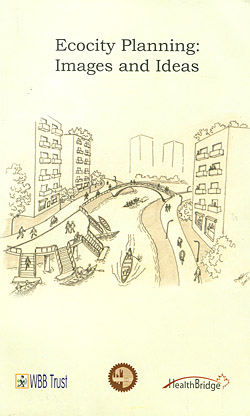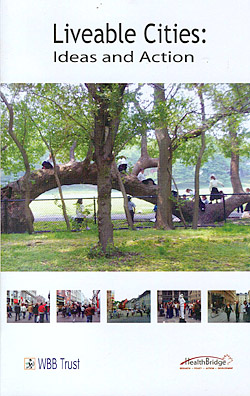
|
||
|
Issue 54 |
|
10 June 2009 |
|
 Rathausplatz, Rothenburg ob der Tauber, Germany ©2007 A. Fox AnnouncementsThe BooksCarfree Design Manual is now widely available in Europe and North America. For some reason, Amazon does not have stock in Canada or the UK. The book is available from Borders in Canada. Amazon may be the easiest and cheapest in the USA.Carfree Cities is widely available in paperback.
Ulrich Nehls valiantly translated Carfree Times into German, starting with issue #32. Uli has told me that he will have
to stop and that issue #53 was his last. Translation is a great deal of work, as I know from direct experience. My thanks
to him for this effort. He will continue to send along interesting stories from Germany.
|
News Bits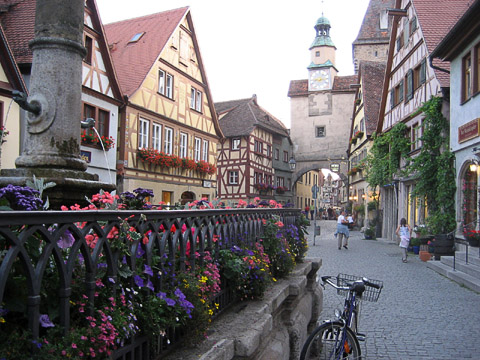 Roder Lane with Markus Tower in the background Rothenburg ob der Tauber, Germany ©2007 A. Fox Copenhagen ConferenceThe recent climate change conference in Copenhagen threw down a number of red flags. It seems that the threat from rising sea levels is greater than had been anticipated. Large areas of Bangladesh, Florida, the Norfolk Broads (UK), and the Thames estuary are threatened. Coastal areas around the world will be inundated by 2100 if the Antarctic and Greenland ice sheets continue to melt faster than expected.The conference was actually only preparatory for the December conference, also slated for Copenhagen. The critical issue in these deliberations will be ice-sheet melting. The IPCC's 2007 report concluded that the sea would rise by between 20 and 60cm in 2100. These figures were based on changes in the ocean's volume as the water warms and from the melting of mountain glaciers. However, the report cautioned that its sea-level rise estimate did not incorporate much from the melting of ice sheets in Antarctica and Greenland. The IPCC felt that the dynamics of polar ice-sheet melting were not well enough understood. Just two years later we are able to make more accurate forecasts, and the news is grim. Scientists have watched satellite imagery as the sea ice around Greenland and Antarctic shores dwindled and disappeared. Sea-ice melting does not by itself cause sea-level rise, but it allows the grounded ice sheets behind them to move rapidly into the sea. Indeed, this is now being seen at a startling pace. Now the fear is that sea level might rise by a meter or more in the next century. Even 2m is not beyond the realm of possibility. And sea levels will almost certainly continue to rise beyond 2100. A rise of 3.5m in 2200 is possible. That would drown many large cities. In the longer term, the melting of the Greenland ice sheets is a terrifying prospect. A global temperature rise of 4°C could completely melt Greenland's ice cover, leading to a rise of 7m. This might take several thousand years, or just a few hundred. Significant sea-level rise also threatens fresh water supplies through contamination with salt. This is already happening in some places. A large increase in major storms is also expected. The resultant storm surge would devastate low-lying areas around the world. Some nuclear power plants would come under flood threat. The congress delivered six key messages:
Climatic TrendsRecent observations show that the worst-case IPCC scenario trajectories (or even worse) are being realized. The climate system is already moving beyond the patterns of natural variability. This includes global mean surface temperature, sea-level, ocean and ice sheet dynamics, ocean acidification, and extreme climatic events. Many of the trends may accelerate, leading to an increasing risk of abrupt or irreversible climatic shifts.Social disruptionRecent observations show that societies are highly vulnerable to even modest levels of climate change, with poor nations and communities particularly at risk.Long-Term StrategyRapid, sustained, and effective mitigation based on coordinated global and regional action is required to avoid dangerous climate change. Weaker targets for 2020 increase the risk of crossing climate tipping points.Equity DimensionsClimate change will have strongly differential effects on people within and between countries and regions, on this generation and future generations, and on human societies and the natural world. A mitigation strategy is needed to protect the poor and most vulnerable.Inaction Is InexcusableWe already have many tools and approaches to deal effectively with the climate change challenge. But they must be implemented to achieve the societal transformation required to decarbonize economies.Meeting the ChallengeTo achieve the societal transformation required to meet the climate change challenge, we must overcome a number of significant constraints and seize critical opportunities. These include reducing inertia in social and economic systems; building on a growing public desire for governments to act on climate change; removing implicit and explicit subsidies; reducing the influence of vested interests that increase emissions and reduce resilience; enabling the shifts from ineffective governance and weak institutions to innovative leadership in government, the private sector and civil society; and engaging society in the transition to norms and practices that foster sustainability.It's a tall order. We must not fail.
"Scientists to Issue Stark Warning Over Dramatic New Sea Level Figures" 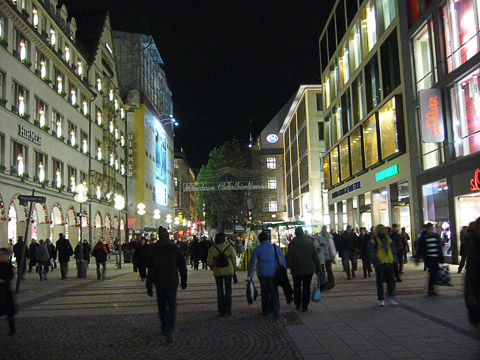 Kaufingerstrasse looking toward Marienplatz, the pedestrianized heart of Munich ©2008 Mark Fleischmann Sustainable CubaIt has long been de rigueur for American statesmen to dismiss Cuba as the poster child for failed states. In fact, Cuba has done remarkably well despite American sanctions. Almost coincidentally, Cuba has become perhaps the most sustainable nation in the world.With the collapse of the USSR, Cuba lost most of its sources of foreign exchange, and with that most of its oil. The measures that were taken in response to this "special period" served to continue a reasonably high quality of life for nearly all Cubans at the same time that carbon emissions were reduced to very low levels. Despised as Cuba is by US politicians, it is an example that the USA would do well to study. At the Earth Summit in Rio de Janeiro 17 years ago, Fidel Castro, like many leaders, called for action. But among those leaders, only he went home and began to actually implement realistic policies for sustainable, low-emission development. Since 1992 the Cuban constitution recognizes the importance of "sustainable economic and social development to make human life more rational and to ensure the survival, well-being and security of present and future generations." It says also that "it is the duty of citizens to contribute to the protection of the waters, atmosphere, the conservation of the soil, flora, fauna and nature's entire rich potential." The response was broad. Cuba has adopted low-fertilizer agriculture and encouraged urban farming to reduce the distances food travels to market. All incandescent light bulbs have been replaced with fluorescents. Rice is cooked in energy-efficient rice cookers. The area of forests has nearly doubled in just 14 years. In 2006, the World Wildlife Federation hailed Cuba as the only country in the world that meets the criteria for sustainable development. Other nations gave lip service to change, or simply denied that action was needed. In nearly all cases their emissions are actually worse than they were at the time of Rio. Why was Cuba different? Armando Choy, a Cuban revolutionary, had a clear answer: This is possible because our system is socialist in character and commitment, and because the revolution's top leadership acts in the interests of the majority of humanity inhabiting planet earth - not on behalf of narrow individual interests, or even simply Cuba's national interests.The remainder of the source article is an anti-capitalist screed that is nonetheless worth reading. The author contends that capitalism's DNA includes the destruction of ecosystems for private profit. Maybe it's not in the DNA, but in contemporary Western capitalism the expression of that DNA certainly behaves so. Capitalism will only save the environment if there is good money to be made doing it. Arranging that would be a neat hat trick.
"Cuba And Dealing with Global Pollution" 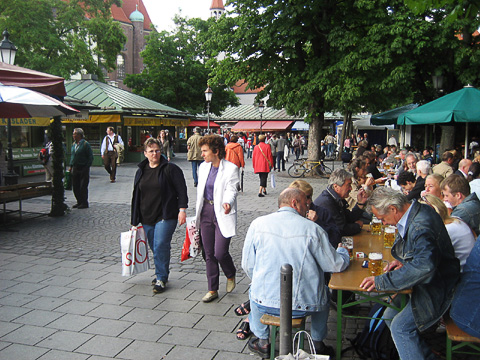 Viktualienmarkt, Munich ©2007 A. Fox Global Warming Is DeadlyGlobal warming causes 300,000 deaths a year and is the greatest humanitarian challenge facing the world. The number could rise to 500,000 deaths a year by 2030. About 300 million people are already affected, according to the first large study of the impact of global warming. These scary conclusions were drawn by the Global Humanitarian Forum, a think tank run by former UN secretary general Kofi Annan. By 2030, climate change could cost $600 billion a year.Civil unrest may also increase, driven by weather-related events. "Four billion people are vulnerable now and 500m are now at extreme risk. Weather-related disasters. . . bring hunger, disease, poverty and lost livelihoods. They pose a threat to social and political stability." The report concludes that if emissions are not brought under control within 25 years:
Water shortages are expected to threaten food production, increase unsanitary conditions, reduce economic growth, and damage ecosystems. The threat to political stability comes as tens of millions of people are driven from their homelands by weather disasters and climate deterioration. The burdens fall disproportionately on the poorest countries. The rich nations, which caused the problem in the first place, are setting aside only a pittance to deal with the consequences for poor nations. They are keeping huge sums to protect themselves. Kofi Annan said, "The world is at a crossroads. We can no longer afford to ignore the human impact of climate change. This is a call to the negotiators to come to the most ambitious agreement ever negotiated or to continue to accept mass starvation, mass sickness and mass migration on an ever growing scale." He continued, "Weak leadership, as evident today, is alarming. If leaders cannot assume responsibility they will fail humanity."
"Global warming causes 300,000 deaths a year, says Kofi Annan thinktank" 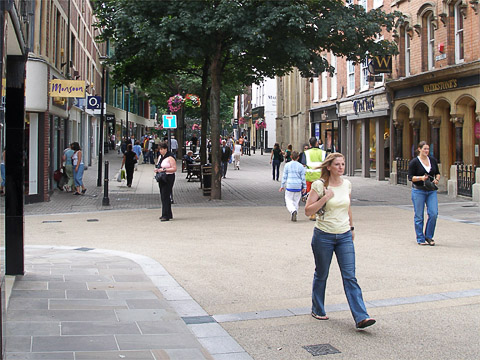 Car-free high street in Worcester, England ©2006 Karen Sandness Vauban Replicated?The New York Times recently stumbled upon the carfree city concept in the form of the relatively new Vauban neighborhood of Freiburg, Germany. Oddly, they label the new satellite town a "suburb," but it is really only suburban in the sense that it is not downtown. (Later, they call it a "district," which is terminology more to my liking.) The district is directly connected to downtown by light rail, which isn't far away in either time or distance.Vauban is pretty much carfree, and owning a car costs $40,000 just for somewhere to park. So 70% of Vaubanís families do not own cars, and 57% sold a car when they moved in. Vauban was completed in 2006 and, according to the Times, is "an example of a growing trend in Europe, the United States and elsewhere to separate suburban life from auto use, as a component of a movement called 'smart planning.'" The "separate suburban life from auto use" is not really accurate, in my view. If you take suburbs as not more than six houses to the acre (say 15 to the hectare), then life in almost any Western suburb is difficult without a car, simply because fast, frequent public transport to the destinations you need cannot be offered at a reasonable cost at such low density. Even low-density urbanism, which involves row houses at least two stories high, is sufficient. The Times then goes on to say, "Automobiles are the linchpin of suburbs, where middle-class families from Chicago to Shanghai tend to make their homes." So, they're a bit confused. But the Times does recognize that cars stand in the way of meaningful reductions in greenhouse gas emissions. The Times: "While there have been efforts in the past two decades to make cities denser, and better for walking, planners are now taking the concept to the suburbs and focusing specifically on environmental benefits like reducing emissions." And they understand that you have to have routine destinations within walking distance, which, again, requires density that is not within the realm of "suburban." The Times: "All of our development since World War II has been centered on the car, and that will have to change," said David Goldberg, an official of Transportation for America, a fast-growing coalition of hundreds of groups in the United States - including environmental groups, mayors' offices and the American Association of Retired People - who are promoting new communities that are less dependent on cars."The rub is: for 60 years, the US government has spent huge sums to subsidize the suburbs. Now there is pressure to save the suburbs by building public transport to serve them. Such systems are uneconomical to operate unless a plan is also in place to increase the density to levels where adequate ridership is generated to support the capital and operating costs of, say, tram systems. The new communities that are envisioned by most "advanced" planners are not carfree at all. They are "car reduced." In many ways this is the worst of both worlds. The car infrastructure needs to be nearly as complete as for standard auto-centric suburbs. This is expensive in both costs and land. Add in the unreasonably high costs of low-density public transport and suburbs become even more expensive than they already are. Unless this is a bailout plan for the suburbs, the numbers don't really add up. The UK, which until recently has been as backwards as the USA on these issues, adopted a new planning paradigm in 2001 that states, "Development comprising jobs, shopping, leisure and services should not be designed and located on the assumption that the car will represent the only realistic means of access for the vast majority of people." Now that's change. And it's apparently real in the UK. The Times says, "Dozens of shopping malls, fast-food restaurants and housing compounds have been refused planning permits based on the new British regulations." There are some straws in the wind. A project proposed for Hayward, California, would mimic some aspects of Vauban. Whether or not Americans are ready to buy is another question.
"In German Suburb, Life Goes On Without Cars" 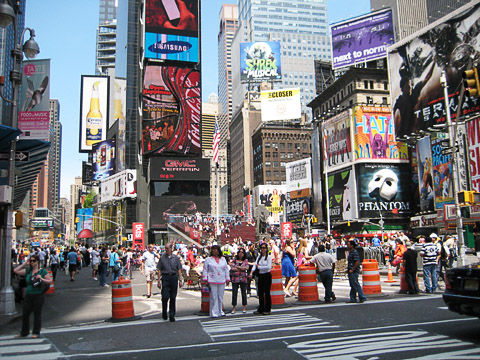 Vicinity of Times Square, Memorial Day 2009 ©2009 Mark Fleischmann Carfree in New YorkNew York City recently closed five blocks of Broadway near Times Square to vehicular traffic. This experiment continues Mayor Bloombergís efforts to reduce traffic congestion. And that's a rather sad point. This wonderful initiative is being undertaken to improve the flow of car traffic. (This would be so because the oblique intersections of Broadway with the avenues have always caused traffic jams.)To be fair, Bloomberg also sees the closures as providing a better environment for pedestrians, which it certainly has done. A minimal effort to furnish the area was already in place when I visited. Some of the space freed up will be used to widen Seventh Avenue within Times Square, to accommodate more traffic. The closure around Herald Square is even smaller, just two blocks. The crosstown streets are not directly affected by the changes. Last summer, the city narrowed Broadway between 35th and 42nd Streets by closing two lanes on the east side of the street. This space was devoted to bikes and a promenade with tables, chairs, and planters. The project was known as Broadway Boulevard and instantly became a popular lunch spot. This treatment might now be applied to the section of Broadway north of 47th Street up to Columbus Circle. The area around Times Square is widely regarded as being too cramped for the number of pedestrians using it, and there has been considerable support leading up to the change. New York drivers were not expected to applaud the change, unless it does in fact speed them through Times Square. Taxi operators were concerned that the might not be able to drop their riders exactly in front of a theater.
 Vicinity of Times Square, Memorial Day 2009 ©2009 Mark Fleischmann On a cool morning in early June I walked up Seventh Avenue from 42nd Street and saw most of the affected parts of Broadway north of Times Square. It looks a little ditzy. Cheap beach chairs litter the street, but even fairly early in the day many were occupied. Underneath it all is still the same paving and pavement markings. Little has been done to recoup the benefits of pushing the cars out, beyond the peace, quiet, and safety. And that, of course, is plenty. During two hours' trudging through Manhattan, it occurred to me that my trip would be much easier on a bike. There's no way I'm riding a bike in Manhattan's vicious traffic, but if we took the cars off the streets, there would be ample room for bikes. Imagine how easy it would be to move around Manhattan if the cars were banished and a large drag-and-drop bike scheme initiated. My (ultimately unsuccessful) effort to find the Guggenheim Museum (and its Frank Lloyd Wright exhibit) would have been easy and pleasant on a bike. As it was, I gave up on 80th Street and took the subway back to the bus station. I'm nursing my new blisters and corns. We should not lose sight of the importance of these rather small trials. If successful, as I expect them to be, they show that life can go on even after some space has been taken away from cars. And they show that life is much better for the people who are not in cars, which is most of them. City transportation commissioner Janette Sadik-Khan said, "Itís amazing how quickly people materialize on the streets when you close them off." That's right. It's only natural.
"Mayor Plans to Close Parts of Broadway to Traffic" 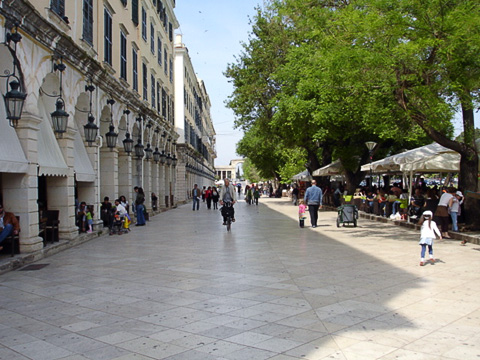 The Liston, Corfu ©2007 Linda Baddeley Commentary by Simon Baddeley The Liston is a kind of perfection. It's old but not a museum. It's grand but not big, and when crowded it's full of intimacy. There are no cars to endanger the children, pollute it with smell and noise. The Liston is a place for walking and sitting and talking and gazing around. It connects to the sokaki, Corfu's intricate back streets, and to the grand square, the cricket ground and the sea. It's open to the Ionian sky but has ready shelter from its generous rain. It is private space where people live as well as work - full of thriving interesting business - and it is a public space that takes civility for granted without pompous notices; an agora for all and an avenue for secular and religious celebrations of joy and solemn gatherings at times of sadness. It stands on its own connected to everywhere. Carfree in MelbourneA carfree district just 2km from downtown Melbourne has been proposed. The Victorian Eco-Innovation Lab calculates that this will equal the removal of up to 5,000 cars from the proposed suburban roads.The new development is to be based on walking, cycling, and electric vehicles. Car sharing would be available at the district edge. Small urban farms and a "multi-story farm" would be included. Medium-density housing (up to eight stories) is proposed. The site is the last remaining major development opportunity near the city center. The state's rail service occupies the land and has rights until 2014. Some 200 students developed the Eco-City idea.
"Car-Free Suburb Planned for Melbourne, Australia" 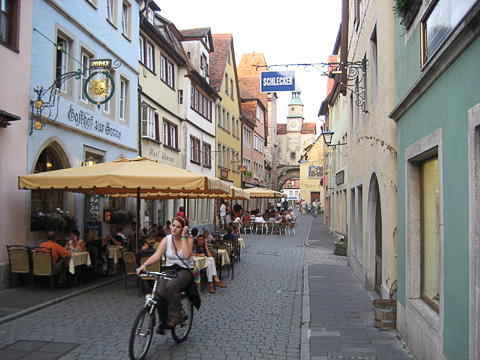 Street in Rothenburg ob der Tauber, Germany ©2007A. Fox Just Crush ItSales of new cars in the USA are lower than the number being scrapped. "Cars were a bubble just like the housing market was a bubble," said Mike DiGiovanni, chief sales analyst for GM. The number of cars on the road had increased every year since the end of WWII.The poor economy and excessive consumer debt are likely to hold down car sales for years, and rising gas prices may crimp sales of high-price, high-profit large cars, making the outlook for auto makers rather grim. This comes as two of the three largest US auto makers filed for bankruptcy. GM's liabilities exceeded its assets by a ratio of about two-to-one. The firms are to be rescued by the US government, which will be the largest owner of the resurrected companies. Many brands will be dumped and a large portion of the dealerships will close forever. An industry spokesman still doesn't get the extent of the damage: "Now people have decided we've got to get back to basics. We have three cars in the driveway. We need to go back to having two." Or one. Or none at all.
"Cars were a bubble"
|
Feature Article
An early plan for a carfree Lyon. Click image for larger version. The Lyon Protocol RevisitedJ.H. CrawfordFirst published in Carbusters #38 (May-July 2009)One of the many fruits of the first Towards Carfree Cities conference, held in Lyon in 1997, was the drafting of a document known as "The Design and Implementation of Large Car-Free Districts in Existing Cities." I was one of the authors of this document and later gave it the descriptor "The Lyon Protocol." It was a rather hasty piece of work, and so far as I am aware, it has never been revised. I reviewed it before starting work on this article, and I am pleased to see that it holds up quite well after a dozen years. Some of the principles it established have since been expanded upon, most recently in Carfree Design Manual, which takes as a fundamental belief that future residents of a carfree district should be the ones to do much of its planning and most of its design. Let us begin with a quick look at the Lyon Protocol. First of all, it recognized the effects of scale. Implementation of small projects would be quite different from larger projects. It was recognized that any large conversion project would require the early involvement of all organizations and individuals who would be affected, including people outside the immediate area of the conversion. Conflicts must be identified early, before they become problems, and broad support for the project must be developed. A data-gathering process, including mapping, demographics, and transport, is an early step. All available information on the site is needed. This is an immense amount of data, but most of it is routinely gathered for large-scope urban planning efforts. A working group would then develop a preliminary concept. This includes the boundaries of the carfree area, proposed changes in traffic circulation, traffic-reduction measures, and the ultimate carfree plan. In particular, freight delivery and through traffic require careful attention, as these concerns can sink a carfree project at an early stage. Phasing was also mentioned as an early concern, because in most cases a sudden conversion to the desired end result is politically impossible. A "carrot-and-stick approach" would encourage good practices and discourage bad ones. Public transport, bicycle, and pedestrian infrastructure would be improved. Measures would be adopted to slow traffic, reduce the space devoted to cars, and restrict parking. Street parking near the center would be the first to go. Cars would be required to park steadily farther away from the center, encouraging people to use public transport or bike. Parking fees would be greatly increased over a period of a few years. Car use would be reduced gradually. The first to go would be private cars of non-residents, followed later by private cars of residents. Traffic cells would discourage cross-city travel. Parking permits would be sold only with a transport pass. One final change is the conversion of freight delivery from conventional trucks to the chosen system. (The retention of truck deliveries during limited hours is an option.) Ultimately, only emergency-service vehicles should be permitted. The news media are essential to a good outcome, but specific plans should not be presented too hastily. The ground must be prepared by a long discussion of the problems caused by cars and the alternatives that solve these problems. The benefits are large and should be stressed from the start. If this is badly handled, resistance might harden at an early stage. The process is inherently political, and the support of local politicians is essential. To secure broad support, the concept plan is presented to each of the affected groups for discussion. As unmet needs are revealed, they will affect the plan. The process of contacting groups and responding to their concerns would continue until all serious obstacles have been overcome. Near the end of the process, a week-long community design workshop, or charette, could be held to manage the more stubborn problems and to secure broad agreement by all stakeholders. The charette could be sponsored by the city government, which by this time should be strongly in support of the plan. Interested parties would join in this brain-storming process, with the objective of reaching consensus on a plan. City planning officials would then develop final plans and phasing. Do make certain that the city's final plan respects this consensus. Major deviations should not be adopted without broad discussion. The Need for a Long-Term Master PlanThe Lyon Protocol did not directly address the question of removing cars from an entire city. This leads to a risk that the implementation of plans in one area might interfere with later expansions of the carfree areas. There are a number of points where this might occur, but parking, public transport, and freight delivery are likely.I do not foresee that cars will completely disappear. Eventually, their use in cities will be largely or entirely prohibited, but a transport mode that reaches rural areas is required, probably involving some continued use of private cars. The interface between rural cars and the city thus requires careful planning. I propose simply to build multi-story parking garages (preferably underground) at the city's edge for visitors' cars and car-sharing vehicles. City residents who regularly need a car to travel outside the city could rent a space. These garages must be linked to the city by good public transport. This is, of course, less convenient than driving directly to a destination within the city and will discourage people from using cars unnecessarily. In Carfree Cities, I proposed the development of "utility areas" at the edges of carfree cities. Utilitarian functions would be located here, including parking, staging areas for freight delivery, warehousing, heavy manufacturing, and other noxious uses. Utility areas require connection to the rest of the city by public transport. For freight delivery I have proposed "metro-freight," an adaptation of passenger metro technology. This system uses standard shipping containers to deliver freight to locations alongside a dedicated freight-only route that runs through the city. Smaller and lighter freight can be delivered short distances by bike or special modes as required. I want to eliminate routine truck traffic in carfree cities. I believe that the carfree city, if it is to exceed a population of, say, 20,000, will depend upon a high-quality public transport system to connect the various city districts. I believe that this should be a rail-based system, such as a tram or underground metro. I am opposed to the construction of any above-ground transport facility. It is simply too ugly, intrusive, and noisy. Buses could be used instead of rail systems, but the quality of service is lower, and operating costs are higher. Finally, buses are noisy and polluting. Even with the advances made by "bus rapid-transit" systems, I hold that they are inferior to rail. The masterplan for a city that is contemplating a widespread conversion to the carfree model must establish the routes for these systems and the locations for the parking garages and other utility functions. These are not decisions that can be taken on the fly. Rail systems do have one serious limitation: they do not accommodate sharp curves. It is true that narrow-gauge trams can turn remarkably sharp corners (often with an ear-splitting screech), but this is a bad design condition that slows service and increases maintenance costs. About 50 years ago, Amsterdam looked at its need for metros and adopted a metro network plan. Some parts of that plan will probably never be realized, but once the troublesome North-South line is finally completed, the city will have a coherent metro network that largely follows the originally-identified routes. This sort of large-scale planning should be commenced at an early date in most cities. It is otherwise likely that awkward conditions will arise that have no good long-term solution. Either the work will have to be done again, at huge expense, or the limitations will have to be accepted as permanent. This leaves us with the conclusion that while small-scale, local projects can proceed largely without consideration of the city as a whole, large-scale conversions must anticipate long-term changes. One point that is likely to be overlooked is the provision of adequate green space. Many existing cities are seriously deficient in parks near the center. Plans for carfree conversions should include the ultimate reversion of some of the more sparsely-settled areas to green space, at the same time that areas near transport halts are made more dense. The need for centralized planning in no way implies that citizens should be excluded from the process. Typically, public input is limited to the conclusion of planning. The planners have already decided what they want to do, in great detail. Changes are difficult to make at that point. A better process involves citizens and their visions at an early stage, with renewed consultation as the plans emerge and are refined. As a matter of practical democracy, this is a better way to proceed. Finally, we must guard against the influences of special interests. Nowhere more than in urban planning are the interests of rich individuals and corporations at stake than in the adoption of a city's master plan. It is probably impossible to eliminate this influence, but a transparent process in which all stakeholders and their concerns are clearly identified will go a long ways towards reducing the corrupting influence of private interests on public planning. In the next issue, we will take up the matter of gradual implementation in more detail.
BooksI have only had time to thumb through these two small books, but they look interesting and come from an excellent source. If you want multiple copies, you should be prepared to pay. It's for a good cause: WBB Trust is Bangladesh's finger in the dike.
The publisher's blurb: Why work with students to create Ecocity designs? The main goal was to encourage students to think differently about cities, considering possibilities that would normally be considered impractical. Rather than simply rejecting anything better as an impossible dream, we need to work to create practical solutions. Only then can we move from questioning "Is it possible?" to "How can we make it possible?' It will take much creativity, initiative, and hard work, but surely we can hope to achieve the benefits of ecocity living.
The publisher's blurb: We need to believe that we can make cities good places, which invovles remembering or recognizing the positive attributes of cities. Related to this, we shouldn't allow transport to destroy our quality of life. Life is much richer when people can access low-cost goods and services on the streets throughout the city; when the low-income have ready access to income-generating activities; and when socializing is considered an important aspect of life to which a fair portion of the city's public places - the streets and footpath - sare dedicated.
Hot New LinksThe links below will open in a new browser window:
National Bus Rapid Transit Institute Beyond Green Roofs: 15 Vertically Vegetated Buildings from WebEcoist European Carfree Areas from Carfree UK Resources at Carfree UK Vauban from Carfree UK Carfree Areas Visited During Summer 2008 [PDF!] by Steve Melia On the Road to Sustainability: Transport and Carfree Living in Freiburg [PDF!] by Steve Melia Cycling in the Netherlands [PDF!] from Ministerie van Verkeer en Waterstaat I Walk in My Street: A Guide to Planning Successful Pedestrian Streets in New York City [PDF!] from Transportation Alternatives
About Carfree Times
Next Issue
Subscribe to Carfree Times
Write for Carfree Times
|
| Editor | J.H. Crawford |
| Send e-mail | |
| URL | http://www.carfree.com/
|
Back to Carfree.com
Carfree Times Home
Back to Carfree Times Issue 53
Forward to Carfree Times Issue 55
E-mail
carfree.com
Copyright ©2009 J.Crawford
 Carfree Times in German
Carfree Times in German